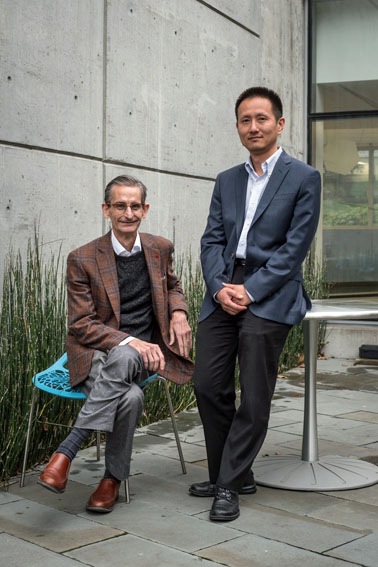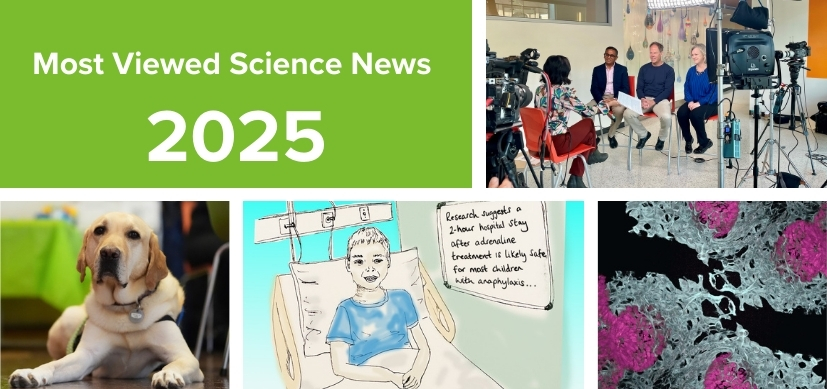Six Gene Loci Associated with Gestational Duration
Research By: Louis Muglia, MD, PhD | Ge Zhang, PhD
Post Date: July 1, 2019 | Publish Date: Sept. 21, 2017

“We have known for a long time that preterm birth is a combination of genetic and environmental factors. This new study is the first to provide robust information as to what some of those genetic factors actually are.”
—Louis Muglia, MD, PhD

A breakthrough discovery from a globe-spanning team of scientists provides the first strong genomic links to preterm birth and provides fresh guidance in the hunt for ways to prevent the world’s leading cause of death among children under age 5.
The study was coordinated by Louis Muglia, MD, PhD, Co-Director of the Perinatal Institute at Cincinnati Children’s and principal investigator of the March of Dimes Prematurity Research Center—Ohio Collaborative. First author was Ge Zhang, MD, PhD, of the Division of Human Genetics.
They worked with researchers from Sweden, Norway, Denmark, Finland, Yale University, the University of Iowa, and the genetic testing company 23andMe. Funding came primarily from the March of Dimes, the National Institutes of Health, the Research Council of Norway, the Swedish Research Council, and the Bill & Melinda Gates Foundation.
LARGE-SCALE APPROACH TO COMPLEX PROBLEM
In addition to the risk of death, preterm birth often leads to lifelong problems including chronic lung disease, vision and hearing impairment, cerebral palsy, and neurodevelopmental disabilities.
“We have known for a long time that preterm birth is a combination of genetic and environmental factors. Previous research has suggested that about 30 to 40 percent of the risk for preterm birth is linked to genetic factors. This new study is the first to provide robust information as to what some of those genetic factors actually are,” Muglia says.
Identifying the biological causes of preterm birth has been a high priority for the March of Dimes, says Stacey Stewart, the organization’s president. “This is a very exciting discovery that can be expected to lead to the development of new treatments to prevent pregnant women from going into labor too soon and to give more babies a healthy start in life.”
Finding the genomic needles of preterm birth risk involved analyzing a haystack of data that was at least five times larger than any previous study of the topic. One dataset included more than 44,000 women who provided saliva samples to 23andMe. Another crucial reference dataset involved more than 8,000 Nordic women from the Mother Child Cohort of Norway (MoBa); The Finnish Birth Cohort (FIN); and the Danish National Birth Cohort (DNBC).

NEW TARGETS FOR PREVENTING PRETERM BIRTH: THE DECIDUA AND MICRONUTRIENTS
The NEJM study reported a number of findings. Among them:
- Identifying six gene loci; EBF1, EEFSEC, and AGTR2, which were associated with both gestational length and preterm birth; and WNT4, ADCY5 and RAP2C, which were associated with gestational length, but not with preterm birth.
- The gene WNT4 strongly suggests that changes occurring in the decidua play a driving role in preterm birth, which indicates a new potential target for intervention.
- Another gene association, EEFSEC, points to the possible role of selenium in a woman’s diet, a micronutrient that had not been seen as important to a healthy pregnancy.

“These are exciting findings,” says Trevor Mundel, President of the Global Health Division at the Bill & Melinda Gates Foundation. “Not only did the study reveal several genes linked to preterm birth, it also identified a simple, low-cost solution—selenium supplements for expectant mothers—that, if confirmed, could save thousands of lives. It’s a great example of the power of public-private partnership.”
This study attracted wide-ranging attention in scientific circles and from the lay press. News coverage appeared on CBS This Morning, Newsweek, the Voice of America, Medscape, HealthDay, and various outlets in Europe. More than 190 Twitter posts from scientists, clinicians, disease advocacy groups and others reached more than 860,000 followers.
“It’s a great example of the power of public-private partnership.”
Since publication, Muglia and colleagues have presented numerous lectures about the findings. The most notable ones have included the Presidential Plenary Lecture at the American Society for Reproductive Immunology in China, a special symposium on the genetics of preterm birth in Rome, and the Mac Keith Press Basic Science Lectureship at the American Academy for Cerebral Palsy and Developmental Medicine.
GATES FOUNDATION FUNDS FURTHER STUDY
Muglia emphasizes that the study represents a beginning point. Potential diagnostic tests, new medications, improved dietary supplements or other changes that could help more women have full-term pregnancies will require several more years of study. However, the follow-up work has begun.
“We have received a Gates Foundation grant to extend the findings in the NEJM paper to non-European ancestry populations in Asia and Africa. It is currently in progress,” Muglia says. “We are also determining whether selenium deficiency, related to one of the genes we identified, is an independent risk factor. In addition, we have several spin-off studies seeking to determine the mechanisms by which the genetic loci we identified are functioning to determine birth timing.”
—By Tim Bonfield
(This article originally appeared in the Cincinnati Children’s 2018 Research Annual Report)
Listen to Muglia speak in the first of a 2-part People Behind the Science Podcast, June 7, 2019.
Listen to Muglia speak in the second of a 2-part People Behind the Science Podcast, June 14, 2019
Read a conversation with Louis Muglia on his collaboration with 23andMe studying preterm births.
| Original title: | Genetic Associations with Gestational Duration and Spontaneous Preterm Birth |
| Published in: | New England Journal of Medicine |
| Publish date: | Sept. 21, 2017 |
Research By







